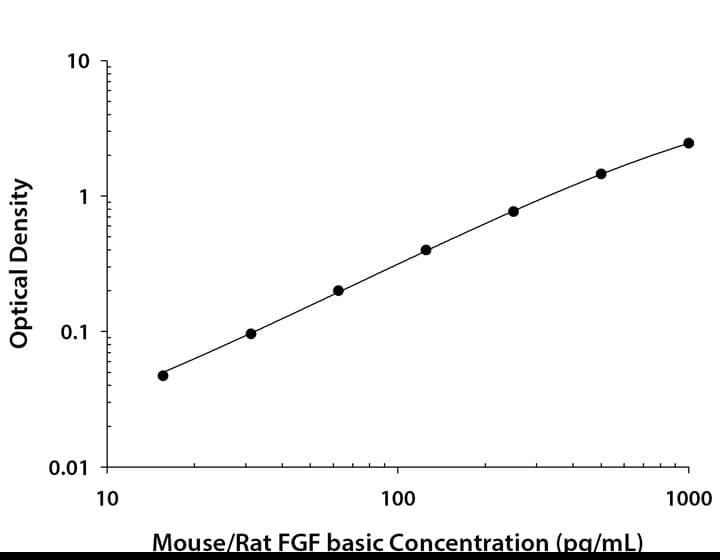FGF basic/FGF2/bFGF: ELISA Kits
FGF basic/FGF2/bFGF is a growth factor that functions in angiogenesis, wound healing, tissue repair, learning and memory, and the morphogenesis of heart, bone, and brain. It is upregulated in response to inflammatory stimuli and in many tumors. FGF basic/FGF2/bFGF binds to FGFR1c and 2c. Its bioactivity is modulated by a number of other binding partners including heparin, Integrin alpha V beta 3, soluble FGFR1, FGF-BP, free gangliosides, Thrombospondin, Pentraxin 3/TSG-14, Fibrinogen, alpha 2-Macroglobulin, PDGF, and CXCL4/PF4. These molecules act as cellular coreceptors or adhesion partners, extracellular matrix decoys or reservoirs, and soluble scavengers or chaperones. In particular, the interaction of FGF basic/FGF2/bFGF with cell surface heparan sulfate proteoglycans (HSPG) is required for the binding and activation of FGF receptors.
6 results for "FGF basic/FGF2/bFGF ELISA Kits" in Products
6 results for "FGF basic/FGF2/bFGF ELISA Kits" in Products
FGF basic/FGF2/bFGF: ELISA Kits
FGF basic/FGF2/bFGF is a growth factor that functions in angiogenesis, wound healing, tissue repair, learning and memory, and the morphogenesis of heart, bone, and brain. It is upregulated in response to inflammatory stimuli and in many tumors. FGF basic/FGF2/bFGF binds to FGFR1c and 2c. Its bioactivity is modulated by a number of other binding partners including heparin, Integrin alpha V beta 3, soluble FGFR1, FGF-BP, free gangliosides, Thrombospondin, Pentraxin 3/TSG-14, Fibrinogen, alpha 2-Macroglobulin, PDGF, and CXCL4/PF4. These molecules act as cellular coreceptors or adhesion partners, extracellular matrix decoys or reservoirs, and soluble scavengers or chaperones. In particular, the interaction of FGF basic/FGF2/bFGF with cell surface heparan sulfate proteoglycans (HSPG) is required for the binding and activation of FGF receptors.
| Sensitivity: | 3 pg/mL |
| Applications: | ELISA |
| Assay Range: | 10 - 640 pg/mL (Cell Culture Supernates, Serum, EDTA Plasma) |
| Sensitivity: | 0.07 pg/mL |
| Applications: | ELISA |
| Assay Range: | 0.313 - 20 pg/mL (Serum, EDTA Plasma, Citrate Plasma, Urine) |
| Assay Range: | 15.6 - 1,000 pg/mL |
| Applications: | ELISA |
| Sensitivity: | 3.68 pg/mL |
| Applications: | ELISA |
| Assay Range: | 15.6 - 1,000 pg/mL (Cell Culture Supernates, Tissue Lysates, Serum, EDTA Plasma) |
| Assay Range: | 46.9 - 3,000 pg/mL |
| Applications: | ELISA |
| Applications: | ELISA |






